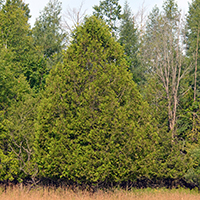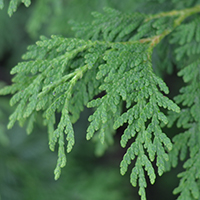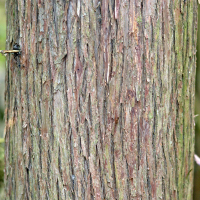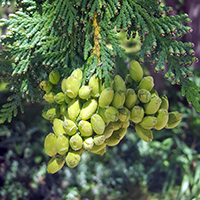What eastern white cedar looks like
Size and shape
- Small, hardy and slow-growing tree.
- Reaches 15 metres high.
- Trunk up to 30 centimetres in diameter.
Needles
- Small, scaly needles cover fan-shaped twigs.
- Yellow-green in colour.
Bark
- Thin and shiny when tree is young.
- Separates into flat and narrow strips as the tree ages.
Fruit
- Cones grow in clumps of 5 or 6 pairs (7 to 12 millimetres long).
Where eastern white cedar is found
Eastern white cedar grows throughout Ontario and is usually found in swampy areas where the underlying rock is limestone.
What you need to know to grow eastern white cedar
- Moisture: grows best in moist soil.
- Soil: grows in a variety of soils, but does not tolerate road salt.
- Shade: tolerates some shade.
- Cautions: Cedar leafminer can cause needles to turn yellow or brown and die.
Benefits and uses of eastern white cedar
Wildlife benefits
White-tailed deer eat or browse the twigs during winter. Small mammals, including hares and squirrels, also eat the stems. Eastern white cedar provides shelter for a variety of bird species.
Commercial uses
Eastern white cedar wood is a popular choice for carpentry due to its ability to endure outdoor conditions. It’s used for:
- exterior finishes, such as shingles, building logs/poles, paneling and fences
- outdoor furniture
- boats and canoes
Because of its small size, eastern white cedar is an excellent landscaping hedge choice.
Current research
To learn about our research on eastern white cedar, visit our science publications catalogue and search “eastern white cedar.”
Fun facts about eastern white cedar
- Eastern white cedar usually lives for about 200 years, but can occasionally live much longer. Eastern white cedar trees more than 700 years old have been found in Ontario’s Niagara Escarpment!
- Oil distilled from cedar needles can be used as an essential oil or in fragrances.
Updated: November 22, 2023
Published: July 18, 2014



